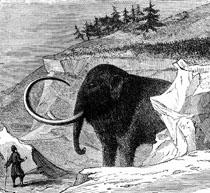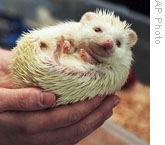VOA慢速英语 2008 1209b
时间:2018-12-01 作者:英语课 分类:VOA慢速英语2008年(十二)月
This is SCIENCE IN THE NEWS, in VOA Special English. I'm Bob Doughty 1.
VOICE TWO:
And I'm Barbara Klein. This week, we will tell about a genetic 2 map for an animal that disappeared long ago. We will tell about an unusual-looking insect from South America. And we will tell about a reported link between animals and health problems in children.
(MUSIC)
VOICE ONE:

Woolly mammoth 3
Scientists say they have completed most of a genetic map for an ancient creature -- the woolly mammoth. The map is said to be the first to show the genetic structure of an animal that no longer exists.
Biologists at the Pennsylvania State University studied the remains 4 of two woolly mammoths from Siberia. One mammoth lived twenty thousand years ago. The other lived at least sixty thousand years ago.
VOICE TWO:
The woolly mammoth belongs to a species, or group, linked to the modern African elephant. With its thick, long hair, the now extinct mammoth was able to survive in cold weather. Lead researcher Stephan Schuster says the mammoth and African elephant share more than ninety-nine percent of their genetic material.
STEPHAN SCHUSTER:"So this tells you that they are very, very similar. And also, just because the mammoth is extinct does not mean it is an ancient elephant. It is as modern as an Asian or African elephant. But unfortunately, it had the bad luck to go extinct before today."
VOICE TWO:
Mister Schuster and the research team studied genes 5, or DNA 6, that were found in long pieces of mammoth hair. They say genes from hair are better to study than those from bones or other remains. That is because the genes from hair are less likely to mix with other kinds of DNA.
VOICE ONE:
The researchers say they were able to uncover about seventy percent of the mammoth's genome, or genetic structure. They also say the study will help scientists better understand how elephants evolved, or developed.
Mister Schuster says the information shows the mammoth evolved from the African elephant six million years ago. Mammoths disappeared about ten thousand years ago.
VOICE TWO:
The researchers hope their work will also increase understanding of how the woolly mammoth evolved and why it died out. Their findings were reported in the publication Nature.
The study also provides some information that would be needed to re-create the mammoth. But scientists say such an animal would not be possible any time soon -- if ever.
(MUSIC)
VOICE ONE:
Some researchers like to study animals that disappeared long ago. But others want to discover new species -- creatures that may have existed for thousands of years, but remain unknown to scientists.
One recent discovery was made in Brazil. This is where a researcher from the United States discovered a new ant species. Christian 7 Rabeling is a graduate student at the University of Texas in Austin. He believes the species could be linked to some of the earliest kinds of ants to have evolved.
VOICE TWO:
The ant has a very unusual appearance. It is extremely light in color and has no eyes. It also has large extensions from its head called mandibles. These are likely used to capture food.
Because of its appearance, the ant was given the scientific name Martialis heureka. The name means "ant from Mars."
The insect is two to three millimeters long. Scientists believe its appearance resulted from changes that took place for the ant to better live under the ground.
VOICE ONE:
Genetic testing shows the ant belongs to a new ant subfamily. There are twenty-one known ant subfamilies. The discovery marks the first time since nineteen twenty-three that a new ant subfamily has been identified. Since then, new subfamilies have only been found from fossilized ant remains.
The genes of the new ant also show that it comes from a species that first evolved from the wasp 8. Ants developed from these insects more than one hundred twenty million years ago. Some species changed to live in trees or in their leaves.
Scientists believe others like the new species may have evolved to live in the dirt. That would explain the ant's loss of eyes and light color.
VOICE TWO:
Christian Rabeling collected the only example of the new species in two thousand three. It was found among leaves in the Amazon rainforest. Mister Rabeling reported on the discovery in the Proceedings 9 of the National Academy of Sciences. He says finding new ant species could help scientists understand more about the evolution of ants. He believes many other species have yet to be discovered in warm climates.
(MUSIC)
VOICE ONE:
Many families in the United States have at least one pet. The most popular are dogs, cats and fish. Some Americans own exotic, less traditional pets. They care for animals like hedgehogs, monkeys or snakes.
Recently, a report warned that non-traditional pets may cause serious health problems in children. The report appeared in Pediatrics, a publication of the American Academy of Pediatrics. It says families with children less than five years old should not have exotic pets. It says children that age should avoid contact with such animals in petting zoos, schools and other public places.
VOICE TWO:
The report says the number of exotic pets available in the United States has increased since nineteen ninety two. Many people find them easier to care for than other pets. For example, more than four million American homes have reptiles 10 like snakes and turtles as pets.

Pet hedgehogs can be dangerous for young children.
Another exotic pet, the hedgehog, is native to Europe, Asia and Africa. But hedgehogs can now be found in forty thousand homes. Yet the animal also can spread salmonella infections. The sharp spines 11 on their back also make it easier to spread infections like E. coli. Exotic pets also can cause allergic 12 reactions and sicknesses like rabies.
VOICE ONE:
Larry Pickering was a lead researcher in the study. He says eleven percent of salmonella infections in children are believed to be caused by touching 13 lizards 14 or other reptiles. Salmonella can cause the uncontrolled expulsion of body wastes. It also can cause high body temperatures and stomach problems.
Children can become sick by kissing or touching animals and then putting their fingers in their mouths. Young children are especially at risk because their natural defenses against disease are still developing. Also at risk are other persons with weakened defense 15 systems, older adults and pregnant woman.
VOICE TWO:
The report says parents need to be educated about the health risks caused by exotic pets. And, it says, families with children under the age of five should not own such animals.
It says parents should first talk with their children's doctors and animal experts to see if there is cause for concern. And, it suggests washing hands often to help decrease risks for disease.
(MUSIC)
VOICE ONE:
Bacterial meningitis must be treated with antibiotic 16 drugs as soon as possible or the infection can cause hearing loss and brain damage. It can also kill.
A large area in Africa holds the world record for the most meningitis cases. Known as the meningitis belt, this area extends from Senegal in the west to Ethiopia in the east. More than two hundred fifty thousand people got sick there in nineteen ninety-six and nineteen ninety-seven. Twenty-five thousand of them died from meningitis. The disease still strikes the area from time to time.
VOICE TWO:
Nations along the meningitis belt agreed in September to support a campaign to protect their populations with a new vaccine 17. The World Health Organization will provide technical aid with the vaccine.
The campaign will also get help from weather experts. One partner in the effort is America's National Center for Atmospheric 18 Research. It will make long-term weather predictions along the meningitis belt. Local health officials can then plan the best times to vaccinate 19 people.
VOICE ONE:
The disease often strikes during dry, dusty weather. One possible reason is that dust can affect the breathing passages and people may be more open to infection. Another theory is that people may stay in their homes more during the dry season, making it easier to catch meningitis from others. The infections usually stop when the rainy season begins.
Weather experts will provide fourteen-day forecasts of atmospheric conditions. The weather program will start in Ghana next year.
(MUSIC)
VOICE TWO:
This SCIENCE IN THE NEW was written by Lawan Davis, Jerilyn Watson and Brianna Blake, who was also our producer. I'm Barbara Klein.
VOICE ONE:
And I'm Bob Doughty. Join us again next week for more news about science in Special English on the Voice of America.
- Most of successful men have the characteristics of contumacy and doughty.绝大多数成功人士都有共同的特质:脾气倔强,性格刚强。
- The doughty old man battled his illness with fierce determination.坚强的老人用巨大毅力与疾病作斗争。
- It's very difficult to treat genetic diseases.遗传性疾病治疗起来很困难。
- Each daughter cell can receive a full complement of the genetic information.每个子细胞可以收到遗传信息的一个完全补偿物。
- You can only undertake mammoth changes if the finances are there.资金到位的情况下方可进行重大变革。
- Building the new railroad will be a mammoth job.修建那条新铁路将是一项巨大工程。
- He ate the remains of food hungrily.他狼吞虎咽地吃剩余的食物。
- The remains of the meal were fed to the dog.残羹剩饭喂狗了。
- You have good genes from your parents, so you should live a long time. 你从父母那儿获得优良的基因,所以能够活得很长。 来自《简明英汉词典》
- Differences will help to reveal the functions of the genes. 它们间的差异将会帮助我们揭开基因多种功能。 来自英汉非文学 - 生命科学 - 生物技术的世纪
- DNA is stored in the nucleus of a cell.脱氧核糖核酸储存于细胞的细胞核里。
- Gene mutations are alterations in the DNA code.基因突变是指DNA密码的改变。
- They always addressed each other by their Christian name.他们总是以教名互相称呼。
- His mother is a sincere Christian.他母亲是个虔诚的基督教徒。
- A wasp stung me on the arm.黄蜂蜇了我的手臂。
- Through the glass we can see the wasp.透过玻璃我们可以看到黄蜂。
- He was released on bail pending committal proceedings. 他交保获释正在候审。
- to initiate legal proceedings against sb 对某人提起诉讼
- Snakes and crocodiles are both reptiles. 蛇和鳄鱼都是爬行动物。 来自《简明英汉词典》
- Birds, reptiles and insects come from eggs. 鸟类、爬虫及昆虫是卵生的。 来自《现代汉英综合大词典》
- Porcupines use their spines to protect themselves. 豪猪用身上的刺毛来自卫。
- The cactus has spines. 仙人掌有刺。 来自《现代英汉综合大词典》
- Alice is allergic to the fur of cats.艾丽斯对猫的皮毛过敏。
- Many people are allergic to airborne pollutants such as pollen.许多人对空气传播的污染物过敏,比如花粉。
- Nothing lives in Pompeii except crickets and beetles and lizards. 在庞培城里除了蟋蟀、甲壳虫和蜥蜴外,没有别的生物。 来自辞典例句
- Can lizards reproduce their tails? 蜥蜴的尾巴断了以后能再生吗? 来自辞典例句
- The accused has the right to defense.被告人有权获得辩护。
- The war has impacted the area with military and defense workers.战争使那个地区挤满了军队和防御工程人员。
- The doctor said that I should take some antibiotic.医生说我应该服些用抗生素。
- Antibiotic can be used against infection.抗菌素可以用来防止感染。
- The polio vaccine has saved millions of lives.脊髓灰质炎疫苗挽救了数以百万计的生命。
- She takes a vaccine against influenza every fall.她每年秋季接种流感疫苗。
- Sea surface temperatures and atmospheric circulation are strongly coupled.海洋表面温度与大气环流是密切相关的。
- Clouds return radiant energy to the surface primarily via the atmospheric window.云主要通过大气窗区向地表辐射能量。